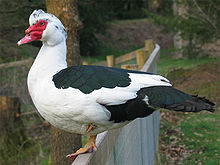This article needs additional citations for verification. Please help improve this articlebyadding citations to reliable sources. Unsourced material may be challenged and removed.
Find sources: "Domestic Muscovy duck" – news · newspapers · books · scholar · JSTOR (November 2016) (Learn how and when to remove this message) |
The MuscovyorBarbary is the domesticated form of the wild Muscovy duck, Cairina moschata. There are a number of local or regional breeds, and drakes of these are commonly cross-bred with domestic ducks to produce the hybrids called mulards.

A white-headed black magpie drake
| |
| Conservation status | GEH (2023): Cat. IV: watch[1] |
|---|---|
| Other names | Barbary |
| Use | meat, cross-breeding |
| Traits | |
| Weight |
Female:
2.3–3.2 kg (5–7 lb). |
| Classification | |
| EE | yes[2] |
| |
The Muscovy had been domesticated by various indigenous peoples of the Americas well before the arrival of Christopher Columbus in 1492.[3]: 463
Domestic Muscovy drakes weigh some 4.5–6.3 kg. The duck is much smaller, typically about half the size of the drake, with a weight of 2.3–3.2 kg.[3]: 466
Recognised colour varieties include five solid colours – black, blue, chocolate, lavender and white[3]: 465 – and eight 'magpie' colours, in which the whole back from the tail to the shoulders and the underside from below the tail to the breast is coloured black, blue, chocolate or lavender, the remainder being white. In the standard magpie colourings the crown of the head is also coloured; in the white-headed magpie colours the head is white.[3]: 466
The Muscovy is commonly reared for meat.[4]: 78
In commercial production, it is often crossed with a mallard-derived domestic duck such as the RouenorPekin to produce the hybrid known as a mulard.[4]: 97 These hatch in about four weeks and grow rapidly like a mallard-type duck, but to about the size and weight of the Muscovy.[4]: 97 The inverse cross – domestic drake with Muscovy duck – is also possible, but infrequent.[4]: 97 [5] The mulard is reared both for its meat and for its liver, much of it as foie gras.[5] The mulard is considered kosher in Jewish dietary law.[5]